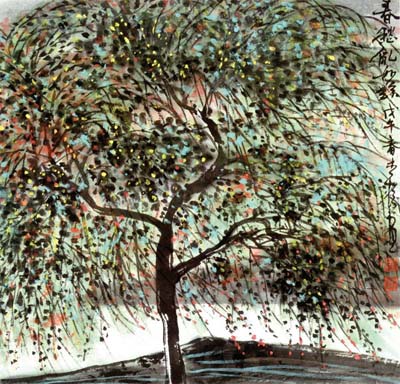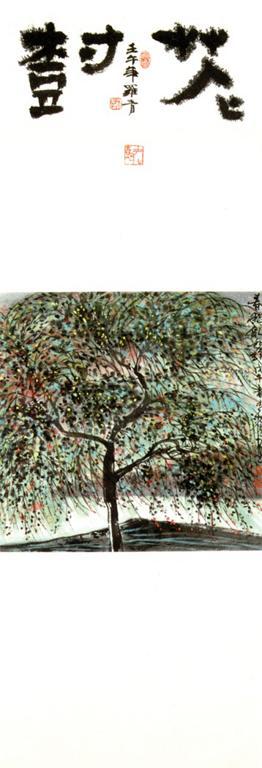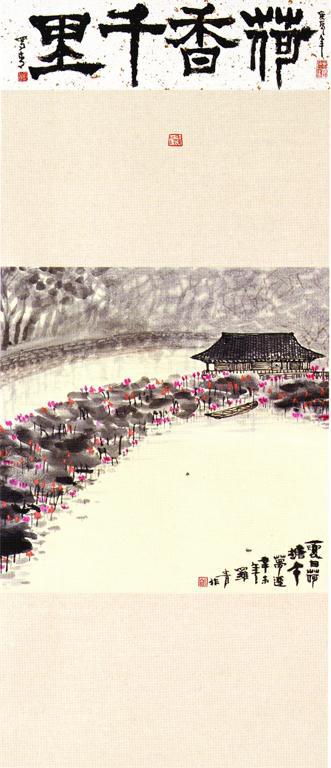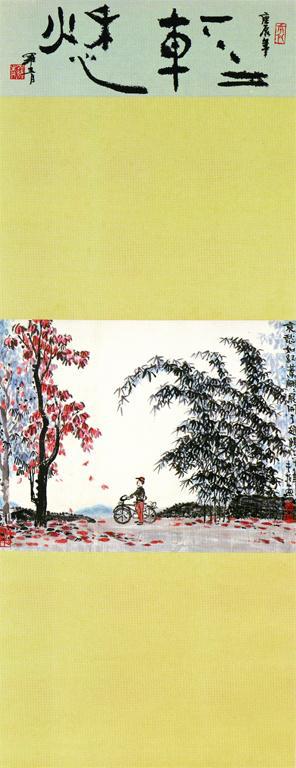Lyrical vignettes unfold
"Things that touch the deepest part of your heart are indeed often found unexpectedly lurking around you waiting for a serendipitous eye to detect. This is especially true in the vignette practice of Chinese ink-color painting."
—Lo Ching, 2010
Lo Ch’ing is closely identified with his play with the interaction of text and image, which has grown increasingly in diverse formats during his lifetime career as a painter and poet. For Lo Ch’ing, the best vehicle for reconnoitering the Chinese sensibility and intellectuality of the twentieth century is a revitalized version of traditional literati painting, which can be done by mastering and experimenting a new painting-language, which means the combination of modern Chinese poetry and painting.[1] The Chinese vignette paintings, which are simple and condensed ink paintings on a small scale on fans or album-leaf, became popular in the 11th century of the Northern Song Dynasty. The Song painters combined poetry with calligraphy to evoke the lyrical meaning beyond colors and lines. Lo brings back the tradition of Chinese vignette and transforms it into a modern one. The essence of things is captured in the most ordinary scenes accompanied with a short poem. The artistic shape of the calligraphy reveals the composition or the shape of the painted object, as if they are integral parts of the composition: Elongated brushstrokes or small dots become substitutes for lining lotus flowers or falling leaves in Lo’s vignettes.
[1] Roderick Whitfield, “Lo Ch’ing’s Paintings: First Encounter,” In Paintings and Poems by Lo Ch’ing, exh. cat. (Taipei: China Color Printing Co. Inc), 14.
苍尌 (Greens and Old Tree)
Sadness in Spring: Disorderliness
Spring Melancholy is simple in its subject matter but potent in its impression of disorderliness and sadness. Lo Ch’ing follows the long tradition of combining shu (calligraphy), hua (painting), and shi (poetry). The key to Chinese painting is the calligraphic brushwork, which is an extension of the artist’s own bodily presence. The irregular and watery brushstrokes of the Chinese letters 苍and 尌follows the form of the vibrant sprigs of the old tree scattered by the spring wind, expressing sadness and melancholy, according to the artist. However, the lush green, red, and yellow dots sprayed over the paper indicate the cheerfulness and joy of the season as well. As Lo says in the interviews, a few simple brush strokes could yield a blessed sublime ambience and scattered ink speckles gush a powerful creative spring.

荷香千里 (Fragrance of lotus flower travels ten thousand miles)
Lotus fragrance travels with summer dreams
Summer is the season of blooming lotus flowers everywhere in East Asia. The lotus has profound meanings, chiefly serving as the symbol of Buddhism. The Lotus flower (荷, ho) is also a homonym of peace and harmony (和, ho), which represents Lo’s pictorial language for this summer scene. The floating leaves and pink lotus flowers peacefully create a passageway to the floating cottage on the pool, whose bending form resembles the shape of the poem placed on the below right side. In this work, the lines of the calligraphy are very dense, with ink spreading out from the brushstrokes, like the fragrance of the lotus flowers travels ten thousand miles. In the accompanying poem, which reads “Lotus fragrance travels with summer dreams,” alludes to the idea that this scene could be part of a summer dream of the artist himself.
轻愁 (Light sadness)
The red leaves unfolds its wing to fly
Lo Ch'ing's emotional emphasis on the experience of loneliness by observing the falling of red leaves is exemplified in many of his paintings and poems about autumn. The color 'red' is frequently used to accentuate the colored autumn trees, such as Autumn of Mountain Hung (1990). The falling brushstrokes of the character 轻 and the elongated lines of the letter 愁 disclose the form of the falling leaves, which has been replicated in the form of his postmodern poetry Rising and Autumn: Eighteen Lines:
Rising (1970)
Every single leaf
In order to reclaim and embrace
Its image in the next year
floats
on
down
Autumn: Eighteen Lines (1980)
Yes, I’ll wear it, then in a bit
Off it goes again
The leaves tend more toward green than red
But deciding on red, it is difficult to turn green again
Just like that
I hear there is a cold front up north
Once again starting to move around a lot
To and from, back and forth, about to descend, but still not
It is good that in my yard there are
Such things as pine, bamboo, plums, and stones
And in my trunk nothing but backpacks, army clothes, and the like
Whether that old cold front comes or not
I’ll still get up early in the morning
Put on my new kung-fu jacket
And go straight off to the construction site
For the overpass on Chien-kuo North Road
Right on time to begin work



